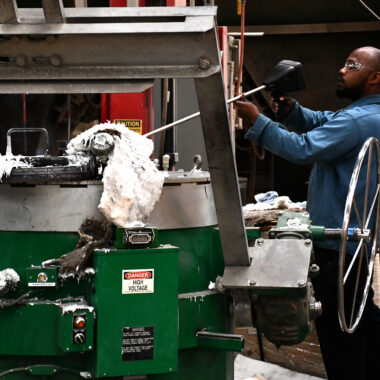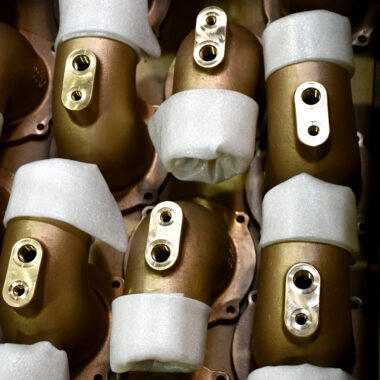Casting Aluminum 101: Important Steps for Novices
Casting Aluminum 101: Important Steps for Novices
Blog Article
Opening the Possible of Light Weight Aluminum Casting: A Comprehensive Summary
Light weight aluminum casting stands as a cornerstone in the realm of metalworking, supplying a wide variety of benefits and applications throughout numerous markets. From its historical value to the modern technologies in casting techniques, light weight aluminum has continuously confirmed itself as a flexible and important product. As we navigate with the landscape of light weight aluminum casting processes and look into the ins and outs of top quality control measures, a comprehensive introduction of opening the real possibility of this steel arises. The possibilities appear endless, encouraging understandings that can change the way we view and make use of aluminum in production (casting aluminum).

Background of Aluminum Spreading
Aluminum casting has a rich historic history that dates back to ancient civilizations, showcasing the withstanding significance of this metallurgical procedure in various sectors. When ancient worlds like the Egyptians and the Sumerians used primary methods to cast tiny objects, the roots of light weight aluminum casting can be traced to around 5,000 B.C.. Nevertheless, it was not up until the 19th century that light weight aluminum spreading saw significant improvements with the exploration of the Hall-Héroult procedure for removing light weight aluminum from its ore, making it much more obtainable for casting purposes.
Throughout the Industrial Change, aluminum spreading gained prevalent popularity due to the metal's lightweight residential properties and deterioration resistance. This resulted in its substantial use in making components for different industries, consisting of automotive, aerospace, and building and construction. The versatility of light weight aluminum spreading permitted for complex shapes and intricate designs to be generated with precision, additionally fueling its fostering throughout various fields. Today, aluminum casting proceeds to be a keystone in the production of a broad array of items, highlighting its enduring tradition and importance in modern-day production processes.
Benefits and Applications
With its remarkable strength-to-weight ratio and superb thermal conductivity, aluminum spreading uses a myriad of advantages and varied applications across various markets. One of the key advantages of aluminum spreading is its lightweight nature, making it an excellent option for industries where weight decrease is essential, such as automotive and aerospace. casting aluminum. Furthermore, aluminum spreading provides exceptional corrosion resistance, making certain sturdiness and longevity in extreme environments. Its high thermal conductivity likewise makes it a recommended option for applications calling for heat dissipation, like in digital components and warm exchangers.
In regards to applications, light weight aluminum spreading is commonly used in the vehicle sector for elements like engine blocks, cyndrical tube heads, and wheels as a result of its toughness and lightweight residential or commercial properties. The construction sector benefits from light weight aluminum spreading in the manufacturing of attractive components and structural components. Moreover, the convenience of light weight aluminum spreading encompasses customer electronics, where it is used in the manufacturing of housings and warm sinks. On the whole, the advantages of aluminum spreading combined with its varied applications make it a critical product in various commercial fields.
Sorts Of Light Weight Aluminum Casting Procedures

Amongst the different methods utilized in industrial setups, light weight aluminum casting processes encompass a series of strategies matched to different applications and needs. One of the most common approaches is sand spreading, where a mold is developed by compacting sand around a pattern of the preferred part. This process is functional and cost-effective, making it prominent for both tiny and large production. One more widely used strategy is pass away spreading, which entails requiring liquified light weight aluminum into a mold and mildew dental caries under high stress. Die spreading permits for high precision and repeatability, making it suitable for producing intricate shapes with thin wall surfaces. Financial investment spreading, additionally referred to as lost-wax casting, is preferred for its capacity to produce thorough and elaborate get rid of a smooth surface area coating. Long-term mold and mildew spreading involves utilizing reusable steel molds to produce constant and top quality aluminum parts. Each of these aluminum casting processes provides unique benefits, dealing with a variety of commercial demands.
Developments in Aluminum Casting Methods
Current innovations in aluminum spreading techniques have actually reinvented the production industry, using improved performance and accuracy in the manufacturing of complex components. One remarkable development is the development of 3D sand printing innovation, which makes it possible for the development of complex sand mold and mildews with marginal hand-operated labor. This technique permits for higher design flexibility and faster production cycles, making it perfect for prototyping and tiny set manufacturing.
Additionally, the use of advanced simulation software application has actually considerably improved the spreading process by making it possible for designers to maximize mold designs and predict possible flaws before production starts (casting aluminum). This leads to enhanced product quality and lowered material waste
Additionally, the fostering of vacuum-assisted light weight aluminum spreading has boosted the general high quality of spreadings by lessening my company porosity and making sure an extra consistent circulation of liquified metal. This technique is especially helpful for elements that call for high architectural stability and exceptional surface area finish.
High Quality Control in Aluminum Spreading
The improvements in aluminum spreading strategies have not only boosted performance and precision however have likewise highlighted the vital relevance of top quality control in ensuring the integrity and performance of cast elements. Quality assurance in aluminum casting entails an organized strategy to keep an eye on and assess the manufacturing process, identifying any kind of variances from set criteria that can influence the end product.
One essential aspect of quality assurance is making use of innovative technologies such as non-destructive testing methods like X-ray and try this out ultrasound to detect inner flaws without compromising the integrity of the cast parts. Additionally, carrying out extensive assessment methods read the article at numerous phases of production aids in recognizing and remedying issues without delay, ensuring that only components fulfilling the defined criteria are launched for use.
Additionally, quality assurance prolongs beyond the manufacturing process to encompass post-casting treatments like warm therapy and surface ending up, assuring that the last products meet the desired requirements. By focusing on top quality control actions, manufacturers can boost item consistency, durability, and total consumer contentment in the realm of light weight aluminum spreading.
Verdict
In final thought, aluminum spreading has a rich background and supplies numerous benefits and applications across different industries. Various sorts of casting processes and cutting-edge methods have been created to enhance the performance and top quality of aluminum casting. Quality assurance procedures play a crucial function in guaranteeing the end products meet the required criteria. In general, aluminum casting proceeds to be a useful manufacturing process with wonderful possible for more advancements in the future.
As we navigate with the landscape of light weight aluminum casting procedures and delve into the ins and outs of top quality control measures, a detailed overview of unlocking the real possibility of this metal emerges. It was not up until the 19th century that light weight aluminum casting saw considerable improvements with the exploration of the Hall-Héroult process for extracting aluminum from its ore, making it much more available for casting functions.
Amongst the numerous methods utilized in commercial settings, aluminum casting procedures include a variety of techniques matched to different applications and needs. Investment spreading, likewise recognized as lost-wax spreading, is preferred for its capability to create intricate and in-depth parts with a smooth surface finish. Different types of casting processes and innovative strategies have been established to improve the effectiveness and high quality of aluminum casting.
Report this page